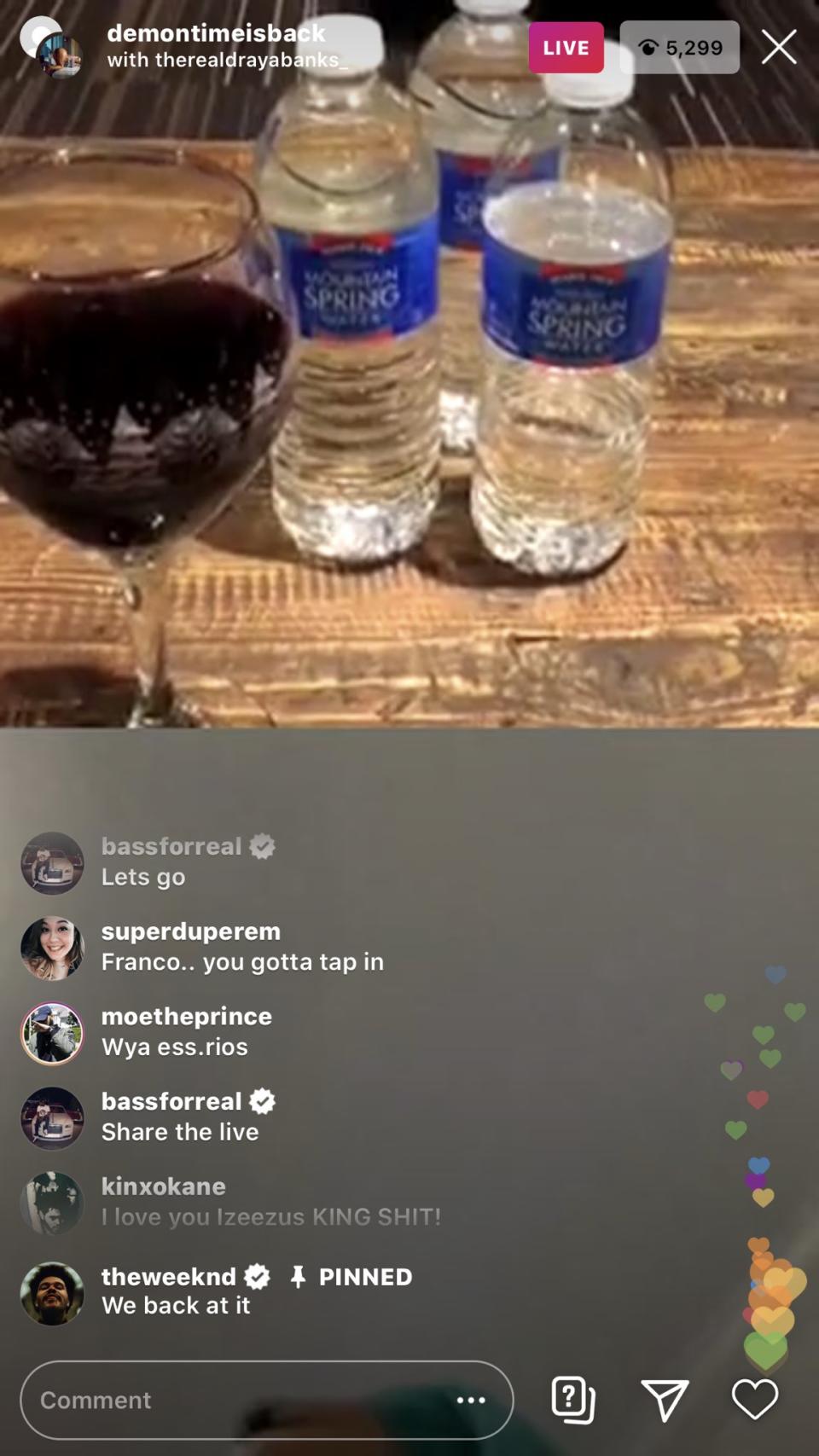Strippers work to 'take back all of the power' while clubs are shuttered during the pandemic

Cristina Villegas, 21, has been working at a strip club in her hometown of Chicago since she was 18, using the money that she makes from dancing on stage, accompanying men to champagne rooms and giving lap dances to cover her bills, to comfortably pay her rent and to fund her increasingly lavish lifestyle. But as the coronavirus hit the United States in early March, Villegas started to see a downturn in both the customers frequenting the club where she works and the amount of money that she was making per night. Then, the club closed its doors in accordance with state protocol.
“I was concerned about contracting the virus and potentially spreading it to others,” Villegas tells Yahoo Life about the nights she last went to work. “The club is not an essential business, and it is a close-contact job so the coronavirus closing down the clubs left all dancers without that large source of income.”
According to a YouTube video Villegas posted April 4 to her channel, which has garnered an audience of 1.35 million subscribers and counting while documenting her life as a stripper, the young woman can make anywhere from $5,000 to $26,000 in one month working five nights a week at the club. As long it has been closed, that income has become obsolete. And while Villegas says she has turned to the money she’s making from her successful social media brand and the sale of her own merchandise to support herself — adding that she is “very lucky” to be able to do so — she acknowledges that for most others in her industry, strippers have been on their own when it comes to finding work.
“A lot of dancers have picked up other jobs at essential businesses, or they have started up an OnlyFans account or a webcam,” Villegas explains, referring to online sex work.
Unlike the transition to digital-only work that many industries have made during this difficult time, strippers face an uphill climb against mainstream social media platforms flagging their content and banning their accounts under the rationale that it violates community guidelines. This is something that Justin Laboy, a former professional basketball player and social entrepreneur, encountered when he stumbled into the world of virtual strip clubs and started his own.
The 28-year-old New York native tells Yahoo Life that he has some experience with nightclub hosting and has learned a lot about the nightlife industry by way of working and socializing throughout New York City. When it shut down, he missed the atmosphere of the clubs he frequented and decided to recreate it on social media. Fortunately, he had a large audience of more than 60,000 followers, made up mostly of women as a result of a meme account that he formerly ran. Still, he couldn’t have imagined what happened next.
“I just went on Instagram Live. I was bored like everyone else. I love to go out. I love the nightlife and that wasn't an option, so I went live for my very first time,” Laboy explains. “[Women] were like calling in and trying to go live with me and I finally answered. ... These girls started dancing and some of the women just started taking their clothes off and I'm like, ‘Whoa, Whoa, we can't do this for free.’”

Laboy says he asked all six or seven women who danced that night for their Cash App user names to be pinned in the comment section of the live stream so that people tuning in would be able to send tips as they would in a strip club. Some of the women received upwards of $4,000 from dancing for just a couple of minutes, according to Laboy.
“The next day I had over like 200, 300 DMs from women asking if they could come on the show because they heard about the money that the women made,” he says. “So it definitely wasn't planned. I just went on one night, I said I needed a demon. I called it ‘Demon Time’ and that just from there kind of took off.”
Like the accounts of countless women who work in the industry, Laboy says Instagram eventually removed him from the platform. Instagram did not immediately respond to Yahoo Life’s request for comment.
With the fandom that he had amassed from the shows he hosted on Instagram and the money that he was able to bring in from Demon Time’s audience of celebrities — including Shaquille O’Neal, Kevin Durant, Odell Beckham Jr., Drake, The Weeknd, Diplo and Winnie Harlow, Laboy was able to secure a partnership with OnlyFans. The platform, founded in September 2016, is a subscription content service that allows creators to make money off of posts from its paying viewers.
We have officially partnered with Demon Time who have created the first ever monetized virtual night club experience using our new dual screen live feature. We would like to welcome @JustinLaboy & @Jdior_ to the OnlyFans Family! Grand Opening of the show on Friday 5/15 😈 pic.twitter.com/xorSGHn9Um
— OnlyFans (@OnlyFans) May 12, 2020
Subscribing to the Demon Time page on OnlyFans is free, although Laboy and his business partner Justin Dior Combs, Sean “Diddy” Combs’s son, charge a virtual door fee starting at $5 for those who want access to exclusive content and the live shows. Beyond that payment, Laboy says all of the money brought in by the dancers goes directly to those women.
“I just feel like this is just the best thing for women right now,” Laboy says. “I try to reach out to as many women as I can. Like, ‘Listen, I don't want nothing from you. I just want to provide you with the opportunity to come on my show.’”
He maintains that it’s all in an effort to build a brand for the women so that they can create money-making opportunities for themselves going forward. And although he sees virtual strip clubs as a lucrative and safe future of the industry, he doesn’t anticipate much competition to what he has created. “I feel like I've separated myself,” he says of Demon Time.
AM Davies, a stripper and longtime advocate for sex workers, explains to Yahoo Life that Demon Time may, in fact, be blocking competition by using its celebrity audience to legitimize the brand and its content, while women who try to promote their individual pages are subsequently being squeezed out and even censored.
“OnlyFans, that whole platform is basically built on sex workers because they caught onto it first. They were using OnlyFans, they made that platform really, really popular and now there are major celebrities that have caught onto it,” Davies, the founder of United Pole Artists explains. “Now OnlyFans is cracking down on sex workers and starting to do weird things with their profiles. So shadow banning and discrimination literally happened on all the platforms.”
In a statement to Yahoo Life, OnlyFans says, “This claim is untrue, OnlyFans never deactivates accounts without due cause. In most cases, creators who violate OnlyFans’ terms have their account restricted or suspended pending investigation and remedial action. In serious cases, such as fraud for example, accounts are deactivated. The platform has experienced very few cases where accounts have been deactivated due to technical glitches, and in these cases the creators have always had their accounts reinstated immediately. Without question, OnlyFans is one of the most inclusive social platforms, and the platform's progressive policies towards content creation enables the success of adult content creators without discrimination. That will not change as the platform grows and gains broader appeal.”
Attempts by strippers to find other opportunities via their online platforms have continued to be difficult. “More of us are online now in a more sexual manner,” Davies says. The desperation to make money has even grown as many states don’t formally recognize strippers as employees, therefore making it more difficult to qualify for unemployment — an issue at the heart of Davies's work with Soldiers of Pole and the motivation behind the fundraiser #StrippingForStrippers.
Still, Davies points to the “resilience” of strippers and the growing unionization of sex workers as the step that will allow the industry to prevail and, more importantly, change for the better.
“We’ve all really become a lot more connected to each other because nobody really understands our plight like we do,” Davies says. “This is the first time we’ve been confronted, without choice, ways that we have to adapt and we have to make it work for us by us from now on. This is our chance to take back all of the power.”
While Laboy claims that he’s working toward the same goal of allowing women to work in an environment where money and rights aren’t being taken from them, Davies proposes a different model where middlemen like Laboy, club owners and house moms — who typically manage the dancers and the workings backstage at strip clubs — are taken out completely.
“The future is strippers will run and own strip clubs cause we’re already all talking about that with each other. Strippers will create more virtual online clubs, they will be run collectively and they will be run fairly amongst the workers,” she explains. “I think that strip clubs should be very nervous that they’re going to lose their establishments and their money because we are going to figure it out on our own like we always do.”
Davies even points to a number of virtual clubs that have already been created by strippers themselves, like CYBERTEASE and TVS Club, as they work to set a precedent for the industry’s future.
Villegas maintains that clubs going virtual “seems like an OK solution for the time being,” although she anticipates going back to work in the club where people thrive off of physical intimacy. “The physical aspect is the main difference between virtual and real life clubs. Over virtual clubs you cannot touch, have a conversation or make a connection at all with guests,” she explains. “It is like the difference between texting someone and meeting them in person.”
In a May 9 video with the house mom of the club where she works, Villegas discussed what strip clubs might look like upon reopening — including wearing face masks and distanced “air dances” — telling Yahoo Life “there will be changes made at first to keep both guests and entertainers safe, but as time goes on, it will all hopefully ease back to normal.”
Although she feels supported by her club, Villegas shares Davies’s vision of a more empowered and connected future for strippers and the environments that they work in. “I hope that people can learn from this experience. A lot of people realized that saving money is so important and moving forward it should be a main focus. I also hope that people use the club as a stepping stone rather than getting trapped in the industry.” Villegas adds, “My hopes for clubs in the future is to work together as a family.”
For the latest coronavirus news and updates, follow along at https://news.yahoo.com/coronavirus. According to experts, people over 60 and those who are immunocompromised continue to be the most at risk. If you have questions, please reference the CDC’s and WHO’s resource guides.
How to maintain your physical and mental health during the pandemic
Taking care of a loved one with COVID-19? Here’s how to stay healthy
Q&A with Dr. Kavita Patel: How to keep your family safe and maintain your mental health
Read more from Yahoo Life:
Want daily wellness, lifestyle and parenting news delivered to your inbox? Sign up here for Yahoo Life’s newsletter.



